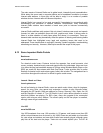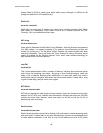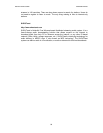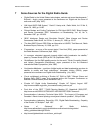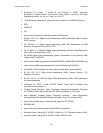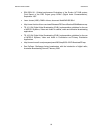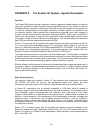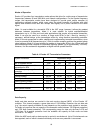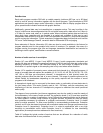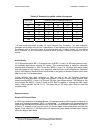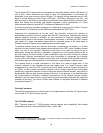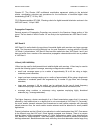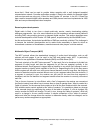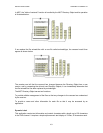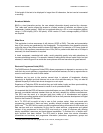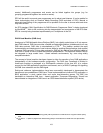DIGITAL RADIO GUIDE APPENDIX A: EUREKA 147
96
Data Services
Each audio program contains PAD with a variable capacity (minimum 667 bps, up to 65 kbps)
which is used to convey information together with the sound program. Typical examples of PAD
applications are dynamic range control information, a dynamic label to display program titles or
lyrics, speech/music indication and text with graphic features.
Additionally, general data may be transmitted as a separate service. This may be either in the
form of a continuous stream segmented into 24 ms logical frames with a data rate of n x 8 kbps (n
x 32 kbps for some code rates) or in packet mode, where individual packet data services may
have much lower capacities and are bundled in a packet sub multiplex. A third way to carry
independent data services is as a part of the Fast Information Channel (FIC) that carries multiplex
control and service information. Typical examples of independent data services that could use the
FIC are a Traffic Message Channel, correction data for Differential GPS and paging.
Some elements of Service Information (SI) data can also be made available to the listener for
program selection and for the operation and control of receivers. For example, the name of a
program service; the program type, title and language; transmitter identification and controls for
switching to traffic reports, news flashes or announcements.
Number of audio services in a multiplex
Eureka 147 uses MPEG 1 Layer II and MPEG 2 Layer II audio compression standards and
permits full data rate coding at the sampling frequency of 48 kHz and half data rate coding at the
sampling frequency of 24 kHz. Half data rate coding is not fast enough to capture all of the
information in a speech signal so this sampling rate is only used where some distortion.
Eureka 147 is capable of processing mono, stereo and dual channel (e.g., bilingual) programs. A
range of encoded data rate options are available (8, 16, 24, 32, 40, 48, 56, 64, 80, 96, 112, 128,
144, 160 or 192 kbps per monophonic channel). In stereophonic or dual channel mode, the
encoder produces twice the data rate of a mono channel. The range of possible options can be
utilised flexibly by broadcasters depending on the quality required and the number of sound
programs to be broadcast.
A stereophonic signal may be conveyed in the stereo mode, or particularly at lower data rates in
the joint stereo mode. This mode, typically used at 144 - 224 kbps, uses the redundancy and
interleaving of the two channels of a stereophonic program to maximise the overall perceived
audio quality.
The degree of error protection (and hence ruggedness) can also be varied to meet the needs of
the broadcasters. In the case of audio services, five protection levels (1 to 5) have been specified
in order to cater for a variety of applications. Level 5 affords the lowest protection and is designed
for cable systems. It allows a high number of program services, but does not have the strong
error protection necessary for operation in multipath environments. Protection Level 3 is better
suited to mobile operation. To allow more flexibility in accommodating subchannels, Protection
Levels 4 and 2 have also been introduced with somewhat weaker and stronger performance than
Protection Level 3 (respectively). Protection Level 1 is suited to applications with a very high
sensitivity to transmission errors while Protection Level 4 is intended for less demanding
applications (for example services addressed to fixed receivers).
Table A.2 outlines the typical number of services that can be delivered for a selection of audio
data rates for different levels of error protection.



